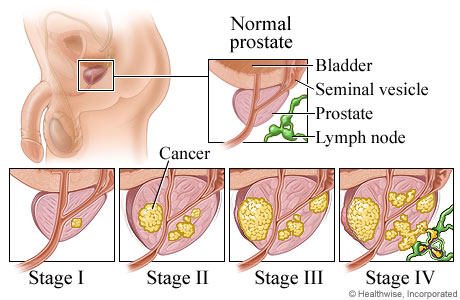 Prostate cancer is the second most common cancer in men which is mostly found in older men. Nearly 1 out of 6 men will probably receive a prostate cancer diagnosis sometime in their lives. The National Cancer Institute estimated that nearly 8% of men between the age range 50-70 will are more likely to be affected with prostate cancer. Considering the statistics of the year 2010, nearly 217,730 men were diagnosed with the disease and about 32,050 died of it so it is the second highest killer for men.
Prostate cancer is the second most common cancer in men which is mostly found in older men. Nearly 1 out of 6 men will probably receive a prostate cancer diagnosis sometime in their lives. The National Cancer Institute estimated that nearly 8% of men between the age range 50-70 will are more likely to be affected with prostate cancer. Considering the statistics of the year 2010, nearly 217,730 men were diagnosed with the disease and about 32,050 died of it so it is the second highest killer for men.
This disease occurs when the malignant cells starts growing in a man's prostate, a gland present in the reproductive system. Cancer occurs with changes in DNA which is the genetic material that contains instructions for development and growth for all cell types. Altered DNA might result into multiplication of normal cells without any order or control and the formation of tumor.
If you happen to catch prostate cancer early i.e. before the cancer cells spread past the prostate then your chances of surviving through the next 5 years is 100%.
Read to check out diagnosis and tests, treatment and care and precautions and cure for prostate cancer.
Prostate Cancer Diagnosis & Tests
Diagnosis:
If any abnormality is noticed in a DRE or PSA test, then your doctor may recommend tests for determining whether you have prostate cancer or not.
- Ultrasound: In case of concerns regarding prostate cancer tests, your doctor may use transrectal ultrasound to evaluate your prostate. In this method, a small probe about the size and shape of a cigar is inserted into your rectum which uses sound waves for making picture of your prostate gland.
- Collecting samples of prostate tissue: If initial test results suggest prostate cancer, then your doctor may recommend a procedure to collect sample of cells from prostate. This procedure is called prostate biopsy and it is often done with help of a thin needle that's inserted into prostate to collect tissue. This sample is analyzed in a lab for determining the presence of cancer cells in prostate.
Prostate Cancer Tests:
Screening of healthy men to detect prostate cancer in men is not recommended by many medical organizations. But some medical organization does suggest men in their 50's to consider prostate cancer detection. You should discuss the benefits, risk of screening with your doctor before deciding which prostate cancer screening is right for you.
Prostate screening tests include DRE and PSA tests:
- DRE (Digital Rectal Exam): In this your doctor will insert finger into man's rectum, to detect any abnormalities. He will feel your prostate through the rectal walls for misshapen or hard areas. This exam usually goes hand-in-hand with the PSA test.
- PSA (Prostate-Specific Antigen) Test: A blood sample is taken from vein in your arm and analyzed for PSA, which is substance that is produced by your prostate gland naturally. Its normal to find presence of small amount of PSA in your blood test, however, if higher than normal level is found then it indicates the prostate inflammation, infection, cancer or enlargement.
Symptoms & Types Prostate Cancer
Symptoms of Prostate Cancer:
Some of you may not be exhibiting any signs even if you already have prostate cancer. The symptoms of prostate cancer are listed below:
- Blood in the urine or semen
- Difficulty having an erection
- Any problem relating to urination
- Frequent pain in the hips, lower back or upper thighs
Types of prostate cancer:
There are few different types of prostate cancer that are named based on the type of cell in prostate that becomes cancerous.
- Adenocarcinoma: According to the American Society of Clinical Oncology, adenocarcinoma is the most common type of prostate cancer as it accounts for more than 95% of prostate cancer cases. It begins in glandular tissue of the prostate cancer. Most andenocarcinoma grows slowly infact most autopsies of men who died from prostate cancer has prostatic andenocarcinoma without their knowledge.
- Small cell Carcinoma: This is an aggressive type of prostate cancer. Dr. Kyle Brownback of Brown University wrote an article published in the Indian Journal of Urology in June 2009 about this type of prostate cancer. The poor prognosis is attributed to tendency for this type of cancer to metastasize early in the disease thereby spreading to other sites within the body.
- Sarcoma: Prostate sarcoma is rare form of prostate cancer that makes up less than 0.1 percent of all prostate cancers. This type of prostate cancer affects men who are in age range of 35 to 60. The tumor in prostatic sarcoma often grows very large, causing obstruction in flow of urine from the bladder and out through urethra. This type of cancer arises from cells that have potential for developing into lymphatic vessels, muscles, connective tissue and blood.
Prostate Cancer Treatment & Care:
Since there is no simple solution to what type of treatment you should receive, hence it is suggested to talk with your doctor for selecting the best option for your lifestyle.
- Watchful Waiting: Since many cancer s take years cause health problems so the right option is to do nothing. You and your doctor can postpone your treatment though you still need to undergo exams.
- Hormone therapy: Undergoing this therapy will block the androgens, hormones that cause growth of prostate cancer. Surgery and use of drugs goes hand-in-hand with this type of treatment.
- Radiology: This treatment uses radiation to kill cancer cells and also known as radiation therapy.
- Surgery: Men with earlier stages of prostate cancer undergo this treatment. There are lots of options as far as the procedure take place which could include your surgeon removing all or part of prostate. Your doctor could do surgery alone or with assistance of a robot or he could operate you by creating cut in abdomen or in between your anus and scrotum.
Prostate Cancer Precautions & Cure:
Diet plays an important role for preventing prostate cancer. A study conducted at Harvard University assessed diets of 50,000 men and learned that those who consumed most fat were twice as likely to develop prostate cancer.
You are suggested to eat tomatoes especially the cooked ones as in tomato sauce as it contains lycopene which is potent fighter against the free radicals that contribute to cancer. Taking vitamin E supplement also help to avoid prostate cancer.
The American Cancer society is reporting 140,000 new cases being diagnosed each year and this is the second most leading cause of cancer death American males. The cost for treating prostate cancer in the US ranges from $10,000 to $135,000 and some of you might not be able to shell out such a huge amount.
References:
- "Prostate Cancer”. National Cancer Institute. Retrieved 12 October 2014.
- “Prostate Cancer Treatment (PDQ®)”. National Cancer Institute. 2014-04-08. Retrieved 1 July 2014.
- Moyer VA, on behalf of the U.S. Preventive Services Task, Force (May 2012). “Screening for Prostate Cancer: U.S. Preventive Services Task Force Recommendation Statement”. Annals of Internal Medicine.
- http://www.indiacancersurgerysite.com/index.html







